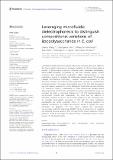Leveraging microfluidic dielectrophoresis to distinguish compositional variations of lipopolysaccharide in E. coli
Author(s)
Wang, Qianru; Kim, Hyungseok; Halvorsen, Tiffany M.; Chen, Sijie; Hayes, Christopher S.; Buie, Cullen R.; ... Show more Show less
Downloadfbioe-11-991784.pdf (1.724Mb)
Publisher with Creative Commons License
Publisher with Creative Commons License
Creative Commons Attribution
Terms of use
Metadata
Show full item recordAbstract
<jats:p>Lipopolysaccharide (LPS) is the unique feature that composes the outer leaflet of the Gram-negative bacterial cell envelope. Variations in LPS structures affect a number of physiological processes, including outer membrane permeability, antimicrobial resistance, recognition by the host immune system, biofilm formation, and interbacterial competition. Rapid characterization of LPS properties is crucial for studying the relationship between these LPS structural changes and bacterial physiology. However, current assessments of LPS structures require LPS extraction and purification followed by cumbersome proteomic analysis. This paper demonstrates one of the first high-throughput and non-invasive strategies to directly distinguish <jats:italic>Escherichia coli</jats:italic> with different LPS structures. Using a combination of three-dimensional insulator-based dielectrophoresis (3DiDEP) and cell tracking in a linear electrokinetics assay, we elucidate the effect of structural changes in <jats:italic>E. coli</jats:italic> LPS oligosaccharides on electrokinetic mobility and polarizability. We show that our platform is sufficiently sensitive to detect LPS structural variations at the molecular level. To correlate electrokinetic properties of LPS with the outer membrane permeability, we further examined effects of LPS structural variations on bacterial susceptibility to colistin, an antibiotic known to disrupt the outer membrane by targeting LPS. Our results suggest that microfluidic electrokinetic platforms employing 3DiDEP can be a useful tool for isolating and selecting bacteria based on their LPS glycoforms. Future iterations of these platforms could be leveraged for rapid profiling of pathogens based on their surface LPS structural identity.</jats:p>
Date issued
2023-02-16Department
Massachusetts Institute of Technology. Department of Mechanical EngineeringPublisher
Frontiers Media SA
Citation
Wang, Qianru, Kim, Hyungseok, Halvorsen, Tiffany M., Chen, Sijie, Hayes, Christopher S. et al. 2023. "Leveraging microfluidic dielectrophoresis to distinguish compositional variations of lipopolysaccharide in E. coli." 11.
Version: Final published version
ISSN
2296-4185
Keywords
Biomedical Engineering, Histology, Bioengineering, Biotechnology